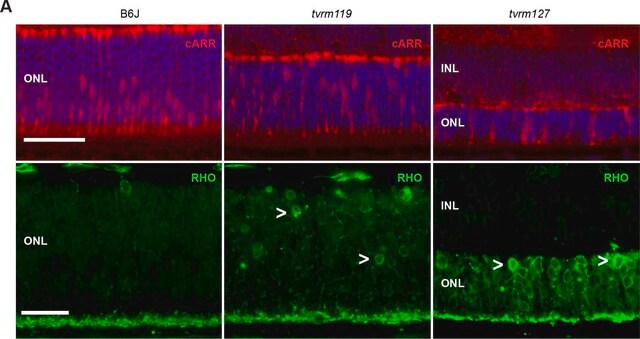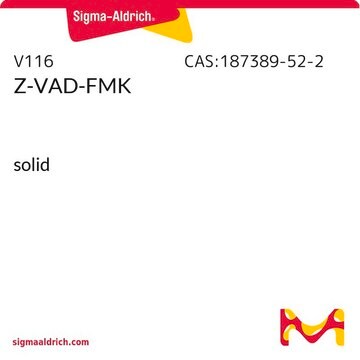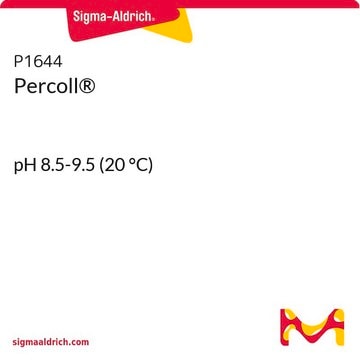추천 제품
Quality Level
종 반응성
human
제조업체/상표
Chemicon®
기술
immunohistochemistry (formalin-fixed, paraffin-embedded sections): suitable
검출 방법
colorimetric
배송 상태
wet ice
일반 설명
Reagents and materials supplied in the Blood Vessel Staining Kit are sufficient for staining 100 tissue sections and when stored at 2-8ºC is stable up to the expiration date. ECM590 detects vWF and CD31 in human paraffin embedded tissues. In rat or mouse tissues only the vWF antibody is effective in paraffin; the CD31 antibody does not react with rodent CD31.
Background:
Angiogenesis and tumor-associated neovascularization are complex processes by which new blood vessels are formed from pre-existing vasculature. Several studies implicate tumor-associated blood vessel formation as a central part in the process of growth, invasion and metastasis of malignancies (Rak et al., 1995; Jahroudi & Greenberger, 1995; Saphir, 1997).
The most widely used endothelial cell markers for studying angiogenesis/neovascularization are von Willebrand Factor (Factor VIII Related Antigen) and CD31 (PECAM-1). von Willebrand Factor is synthesized by endothelial cells, causing adhesion of platelets to injured vessel walls and functions as a carrier and stabilizer for coagulation of Factor VIII. CHEMICON′s von Willebrand Factor antibody reacts specifically with the endothelial cells of blood vessels and is a useful marker for the identification of endothelial lineage in tumors. It is important to note that not all endothelial cells synthesize von Willebrand factor, therefore a small percentage of these vascular-rich tumors might not stain with this antibody. CD31 or platelet endothelial adhesion molecule (PECAM-1), is a type I integral membrane glycoprotein and a member of the immunoglobulin super family of cell surface receptors. It is strongly expressed by all endothelial cells and weakly by several types of leucocytes (Parums et al., 1990). According to several studies, staining of blood vessels with CD31 antibodies has shown to be suitable for the identification of angiogenesis in several types of malignancies such as lung (Giatromanolaki et al., 1996), breast (Horak et al., 1992) and colorectal cancer (Takebayashi et al., 1996). CHEMICON′s monoclonal antibody to CD31 is very specific for the staining of vascular endothelial cells in normal and cancerous tissue.
CHEMICON′s Blood Vessel Staining Kit is a very sensitive immunohistochemical tool for the detection of vascular endothelial cells, containing both anti-von Willebrand Factor and anti-CD31 primary antibodies and is applicable to a variety of species. This immunoperoxidase kit provides a simple, all-in-one method for the staining of frozen and paraffin-embedded sections in human (both CD31 and VWF) or rat and mouse (VWF only) tissues
Background:
Angiogenesis and tumor-associated neovascularization are complex processes by which new blood vessels are formed from pre-existing vasculature. Several studies implicate tumor-associated blood vessel formation as a central part in the process of growth, invasion and metastasis of malignancies (Rak et al., 1995; Jahroudi & Greenberger, 1995; Saphir, 1997).
The most widely used endothelial cell markers for studying angiogenesis/neovascularization are von Willebrand Factor (Factor VIII Related Antigen) and CD31 (PECAM-1). von Willebrand Factor is synthesized by endothelial cells, causing adhesion of platelets to injured vessel walls and functions as a carrier and stabilizer for coagulation of Factor VIII. CHEMICON′s von Willebrand Factor antibody reacts specifically with the endothelial cells of blood vessels and is a useful marker for the identification of endothelial lineage in tumors. It is important to note that not all endothelial cells synthesize von Willebrand factor, therefore a small percentage of these vascular-rich tumors might not stain with this antibody. CD31 or platelet endothelial adhesion molecule (PECAM-1), is a type I integral membrane glycoprotein and a member of the immunoglobulin super family of cell surface receptors. It is strongly expressed by all endothelial cells and weakly by several types of leucocytes (Parums et al., 1990). According to several studies, staining of blood vessels with CD31 antibodies has shown to be suitable for the identification of angiogenesis in several types of malignancies such as lung (Giatromanolaki et al., 1996), breast (Horak et al., 1992) and colorectal cancer (Takebayashi et al., 1996). CHEMICON′s monoclonal antibody to CD31 is very specific for the staining of vascular endothelial cells in normal and cancerous tissue.
CHEMICON′s Blood Vessel Staining Kit is a very sensitive immunohistochemical tool for the detection of vascular endothelial cells, containing both anti-von Willebrand Factor and anti-CD31 primary antibodies and is applicable to a variety of species. This immunoperoxidase kit provides a simple, all-in-one method for the staining of frozen and paraffin-embedded sections in human (both CD31 and VWF) or rat and mouse (VWF only) tissues
애플리케이션
ECM590 detects vWF and CD31 in human paraffin embedded tissues. In rat or mouse tissues only the vWF antibody is effective in paraffin; the CD31 antibody does not react with rodent CD31.
Reagents & materials supplied in the Blood Vessel Staining Kit are sufficient for staining 100 tissue sections & when stored at 2-8ºC is stable up to the expiration date.
Research Category
Cell Structure
Cell Structure
포장
sufficient for 100 sections
성분
Rabbit anti-vWF Polyclonal Antibody (Part No. 21540): One vial containing 100 μg at 1 mg/mL.
Mouse anti-CD31 Monoclonal Antibody (Part No. 90214): One vial containing 100 μL at 15 mg/mL (total protein including IgG and Carrier protein).
Goat anti-Rabbit Secondary Antibody (Part No. 21537): One 15 mL ready-to-use solution containing biotinylated goat anti-rabbit IgG in PBS with a carrier protein.
Goat anti-Mouse Secondary Antibody (Part No. 21538): One 15 mL ready-to-use solution containing biotinylated goat anti-mouse IgG in PBS with a carrier protein.
Blocking Reagent (Part No. 20783): One 15 mL ready-to-use solution containing normal goat serum in PBS with a carrier protein.
Streptavidin-HRP (Part No. 90215): One 15 ml ready-to-use solution of Streptavidin-HRP diluted in Tris-buffered saline (TBS).
DAB Chromogen A (Part No. 90216): One 5 mL bottle of 3, 3′ Diaminobenzidine diluted in TBS.
DAB Chromogen B (Part No: 90217): Two 12 mL bottles of hydrogen peroxide diluted in distilled water.
20X Rinse Buffer (Part No. 90218): One 275 mL bottle of 20X TBS.
Mouse anti-CD31 Monoclonal Antibody (Part No. 90214): One vial containing 100 μL at 15 mg/mL (total protein including IgG and Carrier protein).
Goat anti-Rabbit Secondary Antibody (Part No. 21537): One 15 mL ready-to-use solution containing biotinylated goat anti-rabbit IgG in PBS with a carrier protein.
Goat anti-Mouse Secondary Antibody (Part No. 21538): One 15 mL ready-to-use solution containing biotinylated goat anti-mouse IgG in PBS with a carrier protein.
Blocking Reagent (Part No. 20783): One 15 mL ready-to-use solution containing normal goat serum in PBS with a carrier protein.
Streptavidin-HRP (Part No. 90215): One 15 ml ready-to-use solution of Streptavidin-HRP diluted in Tris-buffered saline (TBS).
DAB Chromogen A (Part No. 90216): One 5 mL bottle of 3, 3′ Diaminobenzidine diluted in TBS.
DAB Chromogen B (Part No: 90217): Two 12 mL bottles of hydrogen peroxide diluted in distilled water.
20X Rinse Buffer (Part No. 90218): One 275 mL bottle of 20X TBS.
저장 및 안정성
Do not freeze or expose to elevated temperatures. Discard any remaining reagents after the expiration date. Do not store kit components or perform staining in strong light, such as direct sunlight.
법적 정보
CHEMICON is a registered trademark of Merck KGaA, Darmstadt, Germany
면책조항
Unless otherwise stated in our catalog or other company documentation accompanying the product(s), our products are intended for research use only and are not to be used for any other purpose, which includes but is not limited to, unauthorized commercial uses, in vitro diagnostic uses, ex vivo or in vivo therapeutic uses or any type of consumption or application to humans or animals.
신호어
Danger
유해 및 위험 성명서
Hazard Classifications
Aquatic Chronic 2 - Carc. 1B - Eye Irrit. 2 - Muta. 2 - Skin Irrit. 2 - Skin Sens. 1
Storage Class Code
6.1C - Combustible acute toxic Cat.3 / toxic compounds or compounds which causing chronic effects
WGK
WGK 3
시험 성적서(COA)
제품의 로트/배치 번호를 입력하여 시험 성적서(COA)을 검색하십시오. 로트 및 배치 번호는 제품 라벨에 있는 ‘로트’ 또는 ‘배치’라는 용어 뒤에서 찾을 수 있습니다.
Brian Hutzen et al.
BMC cancer, 14, 206-206 (2014-03-22)
Medulloblastoma is the most common type of pediatric brain tumor. Although numerous factors influence patient survival rates, more than 30% of all cases will ultimately be refractory to conventional therapies. Current standards of care are also associated with significant morbidities
E R Horak et al.
Lancet (London, England), 340(8828), 1120-1124 (1992-11-07)
Animal models suggest a role for new vessel formation (angiogenesis) in tumours with metastatic potential, and there is some evidence that this is true for human tumours. What is needed is a sensitive and specific label for endothelial cells, and
J W Rak et al.
Anti-cancer drugs, 6(1), 3-18 (1995-02-01)
The growth of solid tumors to a clinically relevant size is dependent upon an adequate blood supply. This is achieved by the process of tumor stroma generation where the formation of new capillaries is a central event. Progressive recruitment of
Philip A Klenotic et al.
The American journal of pathology, 176(4), 2039-2050 (2010-02-20)
Brain angiogenesis inhibitor 1 (BAI1) is a transmembrane protein expressed on glial cells within the brain. Its expression is dramatically down-regulated in many glioblastomas, consistent with its functional ability to inhibit angiogenesis and tumor growth in vivo. We have shown
Salvatore J Frangiamore et al.
Orthopaedic journal of sports medicine, 6(6), 2325967118777825-2325967118777825 (2018-07-07)
Vascular-derived progenitor and endothelial cell populations (CD31, CD34, CD146) are capable of multipotent differentiation at the site of injured ligamentous tissue to aid in the intrinsic healing response. Proximal ulnar collateral ligament (UCL) tears have been reported to have better
문서
Cell based angiogenesis assays to analyze new blood vessel formation for applications of cancer research, tissue regeneration and vascular biology.
자사의 과학자팀은 생명 과학, 재료 과학, 화학 합성, 크로마토그래피, 분석 및 기타 많은 영역을 포함한 모든 과학 분야에 경험이 있습니다..
고객지원팀으로 연락바랍니다.











